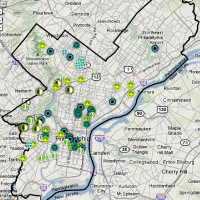Green City, Clean Waters Gets Recognition from World of Architecture
Building Sustainability into Philly's Bones: AIA Pennsylvania Honors Green City, Clean Waters for contribution to architecture.
In Northern Liberties, honeybees drink nectar from native flowers found in a stormwater bumpout at 3rd Street and Fairmount Avenue.
In Point Breeze, kids play basketball on a court that also helps soak up and clean stormwater from the surrounding area.
On Eadom Street in Northeast Philly, patients find therapeutic value in caring for rain gardens that dot the parking lot of their health facility.
Looking across the city, it’s fair to say that Philadelphia’s efforts to protect local waterways from pollution through the use of neighborhood-based green tools has garnered fans who might not usually appreciate a well-designed piece of infrastructure.
On November 10, our Green City, Clean Waters program was being honored by another community not often associated with stormwater management—architects.
The Pennsylvania chapter of the American Institute of Architects, AIA Pennsylvania, honored the City’s multi-decade plan to reduce pollution from stormwater runoff and combined sewer overflows by 85 percent at their 2016 Architectural Excellence Design Awards Gala.
What award do you give a program that rethinks how cities can manage stormwater and seeks to invest in our neighborhoods with green infrastructure projects that make communities more vibrant places to live, learn, work and play?
If you’re AIA Pennsylvania, you give Green City, Clean Waters the Contribution to the Profession by a Non-Architect Award.
According to the group, the award “honors individuals, corporations, associations or other groups who do not practice architecture. Recipients will be cited for their direct contributions to the profession such as a building program, a public works project … or other significant disciplines which have had a strong influence on the field of architecture.”
Over the years, the award has often gone to individuals, ranging from former Inquirer reporter Chris Satullo to Paul R. Levy, executive director of the Center City District.
Given how many people—representing a wide range of professions—have worked to grow Green City, Clean Waters since it officially launched in 2011, it’s fitting that AIA Pennsylvania chose to honor the whole program.
While many individual contributions made it possible for Green City, Clean Waters to surpass some pretty lofty five-year targets for green infrastructure creation and pollution reduction in 2016, the success of the program is driven by hard work in fields including modeling, planning, design, engineering, monitoring, maintenance, public policy, and even community outreach.
By working to together, those working on Green City, Clean Waters at the Philadelphia Water Department have paved the way and made it easier for city as a whole to adopt green stormwater infrastructure as an important part of what a future Philadelphia looks like.
When you look at the crucial role private development is playing in building the network of green infrastructure that exists in Philadelphia today—a network of green systems that will keep and estimated 1.5 billion gallons of polluted water out of our rivers and creeks this year—it becomes clear how important it is to have an architecture community that embraces Green City, Clean Waters.
From a technical perspective, smart stormwater management has become a key aspect of designing and building new structures in Philadelphia thanks to regulations put in place in 2015 that require many new developments to manage most of their stormwater runoff on-site.
All that is to say: we’re honored Green City, Clean Waters is getting recognition from AIA Pennsylvania and the architecture community.
As Philadelphia continues to expand the program and find new ways of managing stormwater, we think recognizing connections between the world of green infrastructure and the world of architecture makes a whole lot of sense.
Thank you to AIA Philadelphia, and congratulations to all the people and partners who have helped make Green City, Clean Waters a success!





